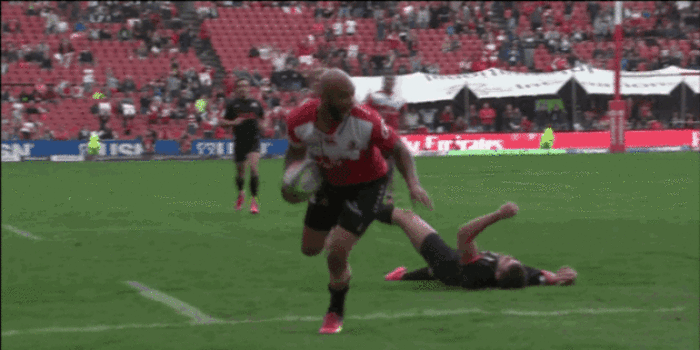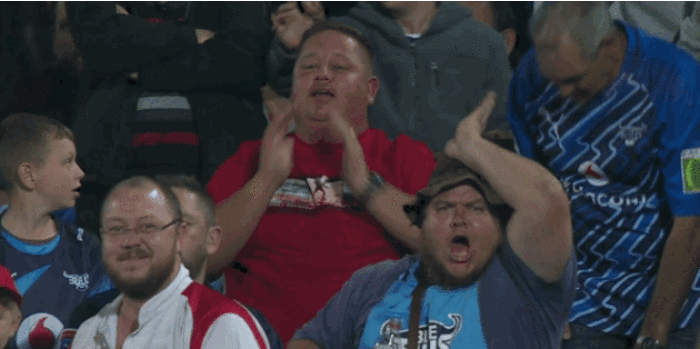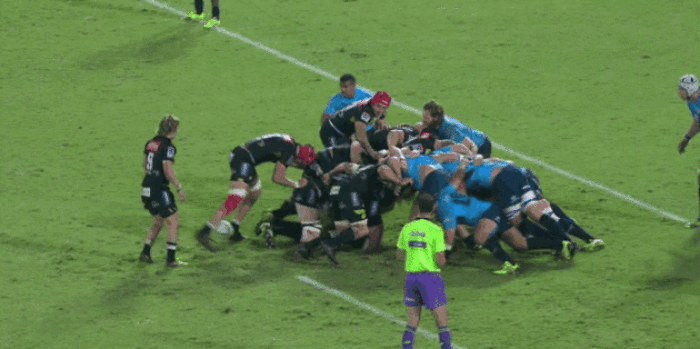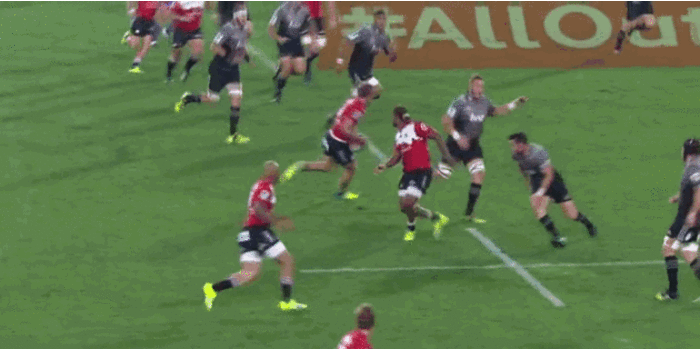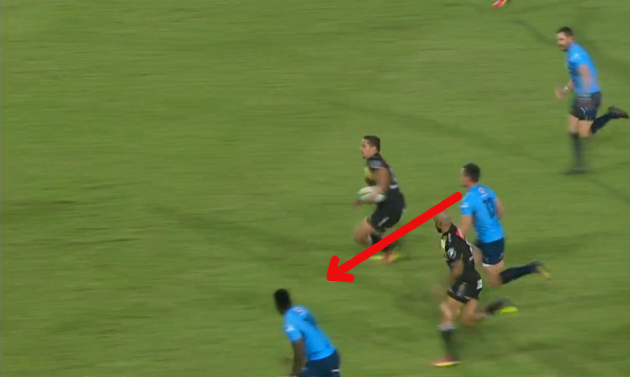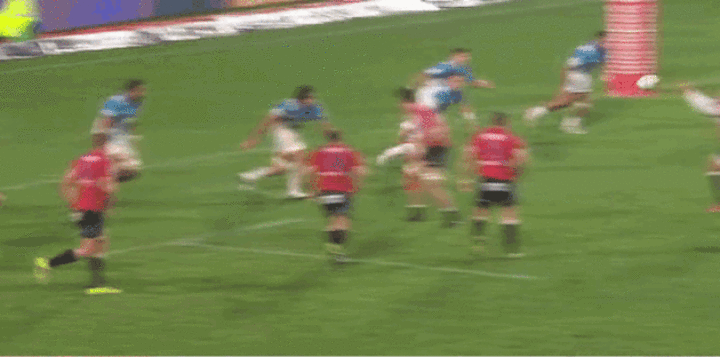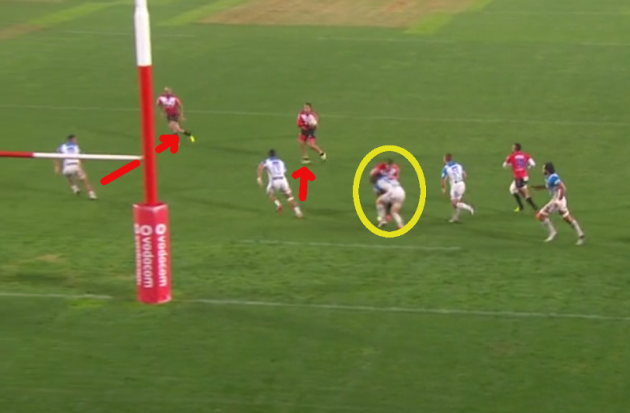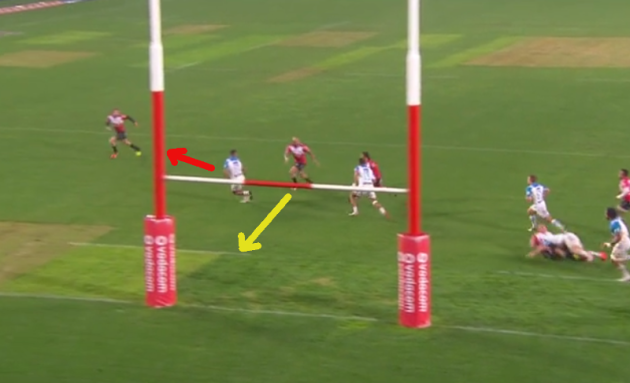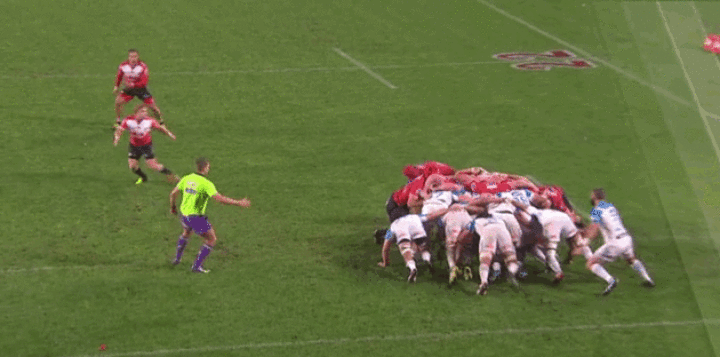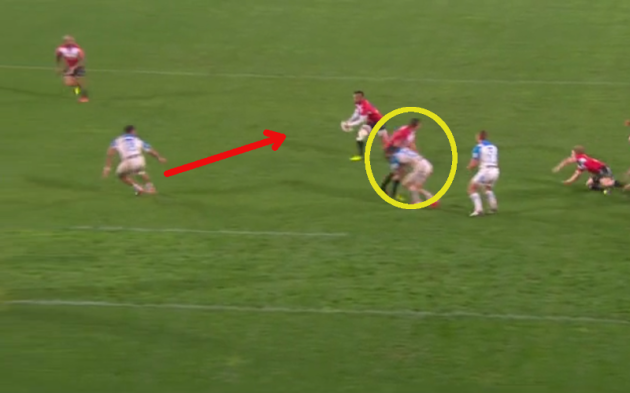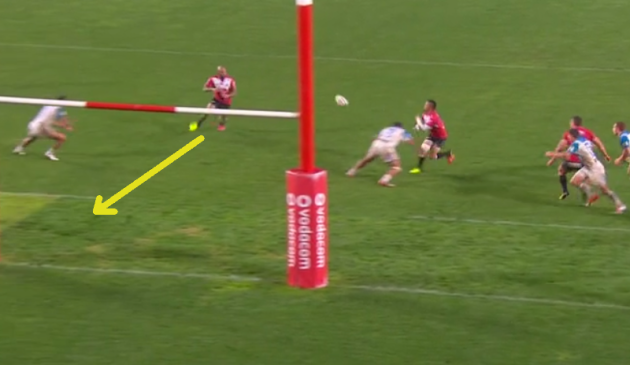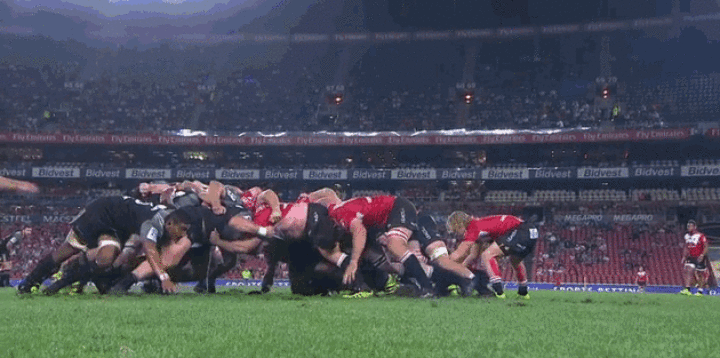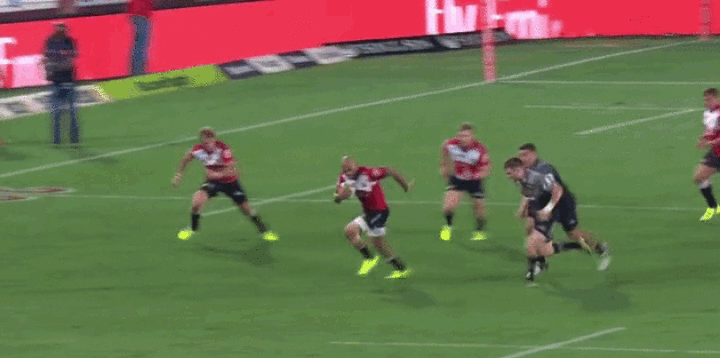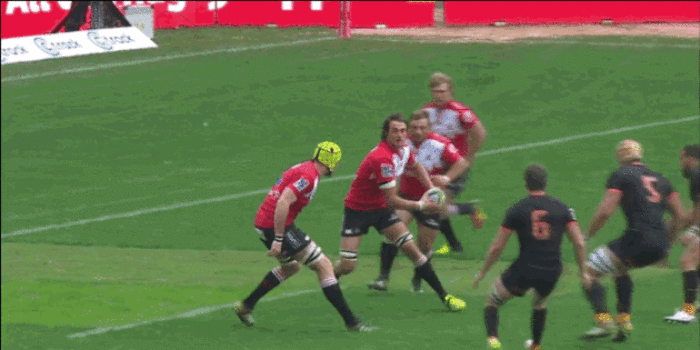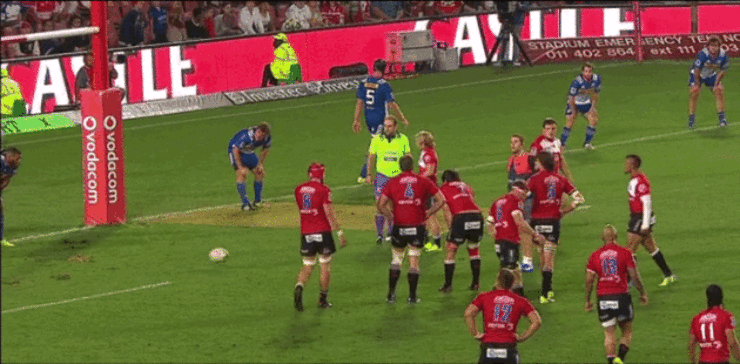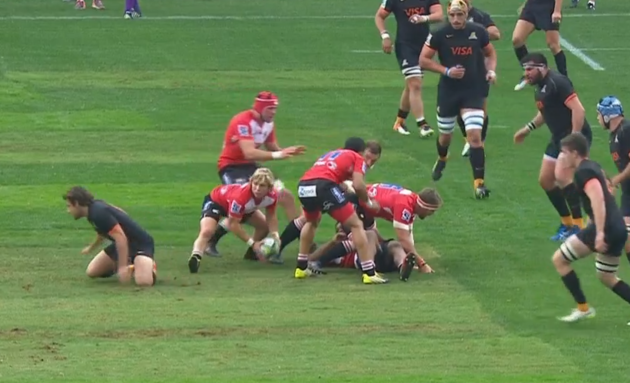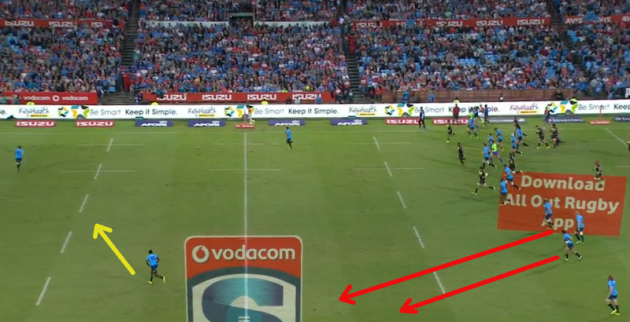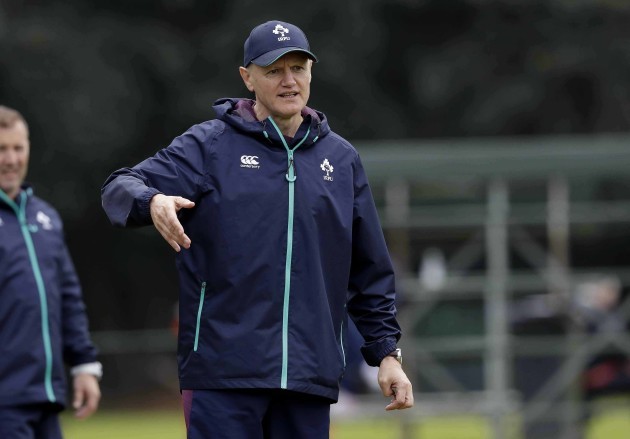SUPER RUGBY FANS have been getting used to Lionel Mapoe’s ‘chicken run’ celebration this season.
The Lions centre, who makes his first start for South Africa at 13 against Ireland tomorrow, has had plenty of opportunity to unleash his unique celebratory salute.
With nine tries in 11 starts, Mapoe is the leading try scorer in Super Rugby alongside the Sunwolves’ prolific Akihito Yamada.
One ventures that Joe Schmidt wouldn’t be the biggest fan of any of his players celebrating tries before they’ve even be scored but Mapoe is clearly a man enjoying his rugby.
The 27-year-old is having the season of his life and, after a debut of just three minutes off the bench against New Zealand in the Rugby Championship last year, he brings real confidence into tomorrow’s clash in Cape Town.
South African fans, like the Bulls follower below, will be hoping to get in on the ‘chicken run’ action.
While Mapoe wins cap number two, his Lions team-mate Faf de Klerk makes his Test debut at scrum-half for the Springboks in another selection that has excited South African rugby.
The 5’8″ livewire has also been in sensational form to help the Lions to the top of the South African conference before the Super Rugby break.
De Klerk is very much in the mould of a ‘classic’ scrum-half. He’s small, fiery, pacy, has an eye for a snipe and constantly looks to keep the tempo high. His selection is the strongest hint that new head coach Allister Coetzee sees his side moving in a new direction.
While the experienced Pat Lambie will provide some balance outside de Klerk, the Lions playmaker is unlikely to curb his attacking instincts.
On the Boks bench, Lions number eight Warren Whiteley was unlucky to miss out on starting, while replacement out-half Elton Jantjies would quite likely have been at 10 but for a recent string of injury issues.
Tighthead Julian Redelinghuys is another whose excellent Lions form sees him included and it is almost certain that all three will have some say in tomorrow’s contest.
Jantjies brings a box of tricks and an ever-growing tactical maturity at out-half, while Whiteley – who has passed more than he’s carried this season – is almost a complete hybrid between an abrasive back row and a multi-skilled centre.
Here, however, we focus on what starting pair Mapoe and de Klerk will bring to the party against Ireland.
Mapoe pace
The Lions have been a joy to watch this season and one reason for that is their clinical use of turnover possession.
De Klerk and Mapoe are utterly comfortable in the transition from attack to defence, with the outside centre particularly ruthless.
We see Mapoe involved twice in the passage above, with his long pass off his left hand releasing fullback Jaco van der Walt to break up the right-hand touchline. Perhaps the most notable aspect of the attack is Mapoe’s acceleration and sheer pace.
He finishes the score with a nice left-hand fend, but it’s the speed at which he moves after initially passing the ball that impresses most.
That pace is a key weapon for Mapoe and it can be very difficult, nigh on impossible, to contain in circumstances like those above. It almost goes without saying that Ireland cannot give up cheap turnover ball and an invitation to counter-attack tomorrow.
As we know, pace can be useless if the player who possesses it isn’t intelligent enough to utilise it in an ideal manner.
Mapoe, however, is hard working off the ball and invariably finds himself on the shoulder of line-breaking players.
His support play is superb, as we see in the instance above, and it’s something Ireland will have to be wary of.
Off-the-ball play works both ways, however, and Ireland can look to limit Mapoe’s influence with intelligent defensive play.
The clip above provides us with another example of Mapoe’s pace but we’re more interested in the actions of opposite number Jesse Kriel – who Mapoe beat for selection at 13 – in defence.
This linebreak comes from a scrum against the head – never easy to defend. It’s inside centre Rohan Janse van Rensburg who makes the bust inside Kriel, beating Jan Serfontein, but Kriel might feel he could have done more to hinder Mapoe’s run.
We can see above that Kriel is tracking Mapoe well initially, before the break inside him means he must spin and potentially tackle van Rensburg as he retreats.
However, Kriel recognises that his fullback, SP Marais, is advancing to hit van Rensburg.
Kriel’s next act must be to ensure that Mapoe does not have access to the ball, either by accelerating into the potential passing route or by leaning into Mapoe and nudging him away from the ball.
Kriel does neither, easing off slightly, and it’s Mapoe’s pace that wins out as he surges onto the pass and batters through the despairing arm tackle of Marais to finish with his trademark celebration.
Ireland’s midfielders, Robbie Henshaw in particular, will be aware of how potent Mapoe is in behind the defensive line with his support play.
Naturally, the ideal scenario is that the frontline is not breached at all in the first place, but off-the-ball work if and when that does occur could be subtly important.
Lines
Even when he is the man making the linebreak, Mapoe’s work off the ball is excellent.
He has produced 20 clean breaks in his 11 Super Rugby games this season, putting him joint-fourth in the overall standings alongside Damian McKenzie and Nemani Nadolo.
The Lions outside centre, who previously played for the Cheetahs and Bulls and spent the first portion of this year in Japan, picks outstanding lines to help him cut open the opposition defence with regularity.
Mapoe has a preference for straightening the line as his team plays from left to right and it’s a trend that Ireland will be aware of.
The above may seem very straightforward, which it is, but it’s a trait that pops up in Mapoe’s play over and over again. He invariably provides the straightening line as the Lions play from left to right.
With Piers Francis getting sat down by the decoy-running van Rensburg, indicated with the yellow circle above, the Blues are left with George Moala and Tevita Li marking up two-on-two with Courtnall Skosan [on the ball] and Mapoe here.
Moala is in a good position to deal with Skosan but already Li is slightly wide of Mapoe.
The Lions outside centre does not need a second invitation.
Even though the Blues have another defender wider to deal with the final attacking player, Li loses track of Mapoe and drifts past him.
With Mapoe having already changed his line, Li can’t adjust as Skosan releases the short pass and the Lions outside centre bursts through to finish strongly again.
It’s only a slight, slight change of angle from Mapoe but that’s all that is required.
We see a similar example in the very same game – Ireland’s defence is going to be a lot stronger than the Blues’ of course – as Mapoe subtly straightens to hammer onto a Jantjies pass for another score.
With Francis again taken out of the equation by van Rensburg’s decoy [yellow below], Moala has to turn back inside to line up Jantjies [red arrow], rather than being able to drift onto Mapoe.
Again, Mapoe identifies the opportunity rapidly and comes on a similar change of angle to exploit the sudden disconnect between Moala and Li.
This pattern is repeated throughout Mapoe’s involvements with the Lions, time and time again.
While it can sometimes appear that Mapoe has done very little for his linebreak other than turn on that impressive burst of acceleration he possesses, it is a skill.
De Klerk is the man with the linebreak assist in the instance above after he loops around Howard Mnisi and, once again, it’s Mapoe who provides the countering straightening line as the Lions play from left to right.
Luke Marshall, Henshaw and left wing Keith Earls, as well as fullback Jared Payne and Conor Murray sweeping across, will be keen to ensure that Mapoe doesn’t get a single opportunity in this regard tomorrow.
Once he’s in behind, Mapoe is very hard to stop.
With 15 offloads in his 11 games, Mapoe is joint-eighth in Super Rugby in this regard and that fact that he makes so many breaks means he can get the hands free.
The majority have come in cases like the one above, where Mapoe has beaten the defence and is offloading on the front foot to support players arriving onto the ball at speed.
However, there have been fleeting instance of Mapoe releasing the ball in the tackle when not in a dominant position. Marshall and Henshaw will certainly look to pressure Mapoe in the tackle and bring about some forced offloads that provide Ireland turnover ball.
Another thing the Irish midfield and backfield defenders will be keenly aware of is Mapoe’s preference for carrying the ball in his right hand.
As soon as possible, Mapoe transfers the ball to his right when carrying and it’s something Ireland’s defence will look to target.
There’s absolutely nothing new in being aware of and targeting an opposition player’s preferred ball-carrying side, but we see Mapoe stripped of possession by Javier Ortega Desio of the Jaguares.
Henshaw and Marshall will be searching for similar opportunities.
Sniper
Scrum-half de Klerk is in his third season of Super Rugby with the Lions and has been one of the stars of the competition in the South African conference.
He was exceptional last season as Johan Ackermann’s side grew but this campaign has underlined that the 24-year-old is far more than a flash in the pan.
As with Mapoe, pace is one of de Klerk’s key attributes and he loves to play the game at an extremely high tempo.
We get a typical example of what de Klerk brings in the clip above. He quick-taps the penalty within seconds of the whistle being blown and immediately burns past Rudy Paige – who benches at scrum-half for South Africa tomorrow.
In behind the Bulls, de Klerk then shows excellent composure to produce a firm left-handed pass on the move to reward Jaco Kriel – a Lions man who is perhaps unlucky to miss out on the Boks 23 – for his hard work in support.
It’s unclear at this stage exactly how much freedom head coach Coetzee is going to give his players, but all the mutterings so far suggest that the former Stormers boss wants to expand the Boks’ approach.
Certainly selecting de Klerk to play a more traditional South African game would make little sense. He is strong in prompting his forwards in their ball-carrying but his real strength lies in opening the game up.
He’s always willing to take slight risks in order to allow his team to attack and the quick-taps – another of which we see above – are never far from his mind.
Ireland will need to retreat 10 metres as swiftly as possible tomorrow when they concede penalties.
De Klerk’s pace obviously means he is very quick to get from ruck to ruck and his passing from the base has been crisp this season.
When passing directly away from the base of the ruck to provide that quick possession he tends to plant the heel of the foot furthest away from the ball, with his toes pointing upwards.
We see that stance above, with de Klerk’s left leg planted close to where he’s scooping the ball up from and his right leg pointing out towards the target of his pass. His right heel is planted into the ground, with the toes lifted up.
De Klerk’s stature, as well as his hard work on the training pitch and in the gym, endows him with an ideal low centre of gravity and his balance is excellent when passing from the base.
De Klerk doesn’t always simply pass from the base, however. We’ve already seen that he can release the ball on the move and Ireland’s fringe defenders will be wary of his arcing runs to either side of the ruck.
Above, we see him fire a sublime pass to beat the edge of the Bulls’ defence and allow the Lions to break.
Any glimpse of space for de Klerk and he will burst through with his pace, as we see below.
In this instance, Bulls lock RG Snyman lunges for de Klerk as the ball comes down from the lineout, prompting tailgunner Lappies Labuschagne to drift away from the back of the lineout.
De Klerk has the strength and acceleration to escape Snyman’s grip, however, and then darts through the gap opened up by Labuschagne drifting off. The Lions score on the very next phase.
While de Klerk may be asked by Coetzee to focus largely on providing that rapid passing service of his, the threat of his darting runs must be at the forefront of Ireland’s defenders on either side of the ruck.
De Klerk is always scanning for his chance and will even attempt to break down the most minuscule of blindside channels if he feels there is space to do so.
Kick counter
Kicking is a core part of any scrum-half’s repertoire and this is perhaps one area where Ireland will look for access into the game from de Klerk.
If Schmidt’s men can be well prepared and hard working in their kick return – an area of the game where they have not excelled under the Kiwi – then there may be opportunities to punish de Klerk’s kicking.
The Lions’ tactics often dictate that de Klerk should kick deep to the opposition but he rarely looks totally comfortable when putting boot to ball. In the instance above, he does find space but the circumstances of the kick are not ideal.
De Klerk is left-footed so Ireland will be keenly aware of that.
Note above how the scrum-half kicks without any ‘screen’ in front of him. In instances such as this, it’s always preferable to have team-mates on their feet to the side of the ruck, creating a shield for the scrum-half to kick from behind.
De Klerk has a habit of kicking the ball before any such guard is in place. The likes of Devin Toner will be waiting to pounce with block-downs if de Klerk opts to kick without a screen tomorrow.
Furthermore, de Klerk kicks the ball before there are genuinely viable chasers on either side of the ruck, meaning that the Lions are not going to be able to pressure the Bulls immediately.
The challenge for Ireland is to work hard enough when retreating that they can launch a threatening counter attack.
We can use the above as an example of what Ireland will need to do if they are to launch back at the Boks. Ireland fullback Jared Payne is full of counter-attacking instinct so he will be eager to punish any poor de Klerk kicking – if allowed the freedom to do so.
Ireland’s retreating openside wing will need to work extremely hard to get towards midfield [as with the yellow arrow above] to provide support to the fullback and wing on the other side of the pitch.
Meanwhile, the likes of Marshall and Henshaw in the midfield will be attempting to get back and provide the width for a counter-attack on the far side of the pitch. It’s utterly basic stuff but requires hard work and the mindset that any poor kicks from the Boks are real try-scoring opportunities for Ireland.
We get an example of a team punishing a poor de Klerk box kick in the clip above, as the Chiefs score with a superb kick return.
Again, de Klerk kicks without any screen and the box is too long with too little hang time – an open invitation for the Chiefs to come back at the Lions. The Kiwi side have enough time to make three passes across the pitch to a centre, Seta Tamanivalu, holding width.
Ireland may not run over players as easily as Tamanivalu – set for his New Zealand debut off the bench tomorrow – does here, or offload as freely, but the point is that de Klerk’s kicking can provide chances to make big gains if they are willing to genuinely counter.
The positioning of Payne at fullback is encouraging in that regard.
Ireland’s test
It’s obvious that Ireland will be looking to thoroughly test Mapoe and de Klerk in the opening exchanges in Cape Town tomorrow.
Mapoe has looked comfortable in defence in Super Rugby this season but hasn’t been targeted in the manner Ireland are likely to do.
Damien de Allende at inside centre is a dynamic specimen but he has something of a bad habit of making mis-reads in defence and leaving his midfield partner at sea.
Joe Schmidt will almost certainly have concocted a range of plays for Ireland to attempt to open up the unfamiliar Boks centre pairing, so Mapoe and de Allende will expect plenty of decoy runners and traffic in front of them as they look to make a defensive impact.
De Klerk is a willing tackler although his relative lack of size can make his covering duties as a sweeper more difficult. Up in the coaches’ box, Schmidt will be keeping a close eye on the scrum-half’s defensive movement off set-piece and in phase play, searching for any hint of a potential weakness to exploit.
Mapoe and de Klerk bring major confidence and form into tomorrow’s test on the back of the Lions’ excellent season, but Schmidt’s players – as ever – will know exactly what’s coming. Ensuring they limit the Lions pair’s influence is the real job.
The42 is on Snapchat! Tap the button below on your phone to add!
